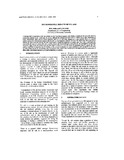| dc.description.abstract | Alarmingly high accumulation of fly ash has led geochemical engineers into finding a solution for the use of flyash as a construction material in the recent past. As of now, although the material has been used in a limited way in the construction of roads, embarkments,dykes and by cement industries, most of it is still dumped as a waste material. There is a general opinion mongst teh Geochemical engineers that fly ash is a non-hazardous material. However, the authors felt that it may not be entirely true due to the fact that fly ash does contain quite a significant proportion of soluble salts. These salts would leak into water if fly ash comes into contact with water or if the ground water leaked through a bed of fly ash. The investigation revealed that Dissolved Oxygen of fly ash polluted tap and clean water is reduced to a level far below the permissible limit for aquatic life. The author would like to emphasise that the findings of the present investigation are being submitted to open an agenda on the issue of water pollution by the fly ash leachate, may it be ground water, water in the vicinity of the ash being used in the construction of dykes,dams, river training structures or for reclamation on sea shores. | en_US |

